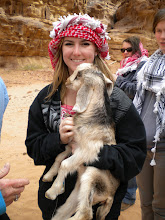The settlement:


Military trenches:


Later we went to a marketplace run by older conservative Druze men and women. There were very few people there so it was easy to walk around from stand to stand to see what each person was selling. The women loved me and had me sit with them behind their fruit stands. They asked me a million questions in Arabic which I could barely understand and they placed plates upon plates of fruit on a small table in front of me and said “Cullee!!! Cullee!”, which means, eat, eat!! I stuffed my face with plums, apples, and peaches and when it was time to leave they sent me off with some homemade bread that had lebeneh, a special kind of cheese, all over it. I asked if I could take their picture and they said “la!” which means no in Arabic, so I could only sneak a few. We bought some fruit and honey to take home.


There were soldiers walking around in the streets

Dr. Taisseer brought us to his apple orchards
 We returned to the Golan for Development and watched the little kid’s camp singing performance and met the doctor’s young daughter.
We returned to the Golan for Development and watched the little kid’s camp singing performance and met the doctor’s young daughter. 


On the way home we swam at the beach again in Tiberias then walked around the city. Before 1948 it was a Palestinian city. In 1947 when the state of Israel was established the Israelis expelled the Palestinians and took over Tiberia, as well as the southern half of the Sea of Galilee (Syria controlled the other half). From 1947-1967 Tiberia was not developed as a city, because according to the Israelis it was too close to the border with Syria. The sea was used for irrigation, fishing, and as water supply for the city. In 1967, after Israel captured the Golan Heights, Israel then controlled both the north and south shores of Tiberia. The north side, which is rich agricultural land, was prime real estate for the establishment of many hotels and kibbutz, such as Ein Giev. The south side was developed into a tourist area, and the west side of the lake, where most of Jesus performed his miracles, is now church controlled land.
You can still see remnants of the erased Palestinian village scattered throughout the shiny urban center today. It is almost impossible to believe an entirely different society once flourished there before they were forcefully banished, but I guess that is the point right?



Read this sign; it says there were PEOPLE killed, which means they acknowledge that people were there, but it fails to mention that those people were Palestinians




No comments:
Post a Comment